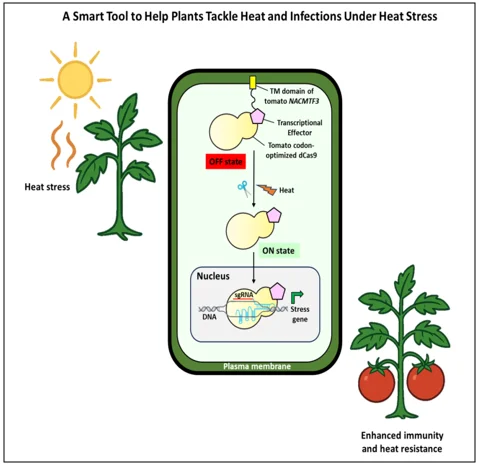CRISPR Technology for Climate-Resilient Crops | 30 Jun 2025
Scientists from the Bose Institute, under the Department of Science and Technology (DST), have developed a novel CR-9ISPR-dCas9-based molecular tool that enhances plant resistance to heat stress and pathogen attacks.
CRISPR-dCas9-Based Molecular Tool
- CRISPR-dCas9: It is a modified version of the CRISPR-Cas9 gene-editing tool. In this version, the Cas9 protein is made inactive, meaning it can no longer cut DNA. However, it still uses a guide RNA (gRNA) to find and attach to specific DNA sequences.
- While regular CRISPR-Cas9 works by cutting DNA to make changes in the gene, CRISPR-dCas9 does not cut the DNA. Instead, it acts like a gene switch by turning specific genes on or off without changing the DNA itself.
- This makes it useful for safely controlling when certain genes, like stress-response genes in plants, are activated, only when needed, saving energy and improving efficiency.
- CRISPR (Clustered Regularly Interspaced Short Palindromic Repeats) is a gene-editing technology that uses the Cas9 protein and a guide RNA (gRNA) to act as genetic scissors, enabling precise cutting, removal, addition, or alteration of DNA sequences in living organisms.
- Working Mechanism: Plants often face stress due to extreme weather or pathogen attacks, which reduces their productivity and growth.
- CRISPR-dCas9 helps plants respond only when under stress using a transmembrane (TM) domain from a tomato protein (NACMTF3) to keep a modified protein, dCas9, outside the nucleus under normal conditions.
- During stress (like heat or pathogen attack), the TM domain releases dCas9, which then enters the nucleus and activates specific defense genes.
- Under pathogen attack (e.g., Pseudomonas syringae), it activates CBP60g and SARD1 immune response genes, boosting immune responses, and under heat stress, it activates NAC2 and HSFA6b, improving water retention, leaf greenness, and thermotolerance.
- Application: Tested on tomato, potato, and tobacco, it showed the highest effectiveness in tomato plants.
| Read More: First Successful Use of Customised Base Editing |

